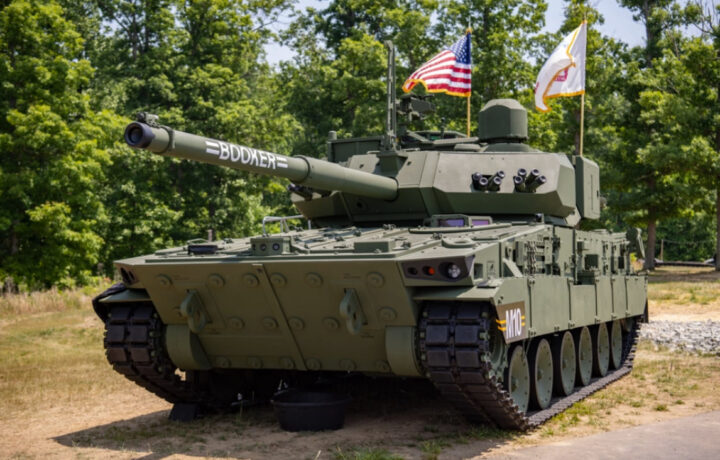The United States Army announced it was canceling the M10 Booker, which was developed as part of the Mobile Protected Firepower Vehicle (MPFV) program. Designed by General Dynamics Land Systems (GDLS) to enhance the U.S. Army’s Infantry Brigade Combat Teams (IBCTs), the vehicle entered low-rate initial production (LRIP) last July.
However, the service opted to cancel the program just hours after U.S. Secretary of Defense Pete Hegseth and top Army official introduced a massive service-wide shake-up that calls for combining the Army Futures Command and Training and Doctrine Command. The service has also halted the Robotic Combat Vehicle (RCV) program while it has paused the new howitzer competition.
Around 80 of the M10s have already been delivered.
A Light Tank That Was Too Heavy
It might be safe to say that the United States Department of Defense likely avoided a sequel to the HBO satire The Pentagon War. The 1995 film was based on the book The Pentagon Wars: Reformers Challenge the Old Guard, written by retired Colonel James G. Burton, United States Air Force (Retired), about the development of the Bradley Fighting Vehicle.
Those familiar with the made-for-TV movie will recognize that the M10 Booker was heading into familiar territory as the M3 Bradley. That vehicle infamously evolved from a light troop carrier into a bulky tank-like vehicle that could only carry half of its original capacity.
The M10 Booker had faced similar scrutiny. It was the first major combat vehicle developed for the U.S. Army since the 1980s, and had been seen as being crucial for the service’s transformation to dominate large-scale combat operations. Armed with a 105mm cannon on a turret mounted to a tracked chassis, it would be easy to confuse the Booker with a tank, and that is where the problems began.
“Now that we’re canceling, you can call it whatever,” U.S. Army Secretary Dan Driscoll told reporters Thursday, according to Task and Purpose. “We got the Booker wrong. We wanted to develop a small tank that was agile and could do [airdrops] to places our regular tanks can’t.”
However, much like with the M2 Bradley as development of the M10 continue, it increased in weight. It resulted in the Booker weighing 38 tons, which meant it could no longer be airdropped. It was also too heavy to be carried on a Lockheed C-130 Hercules transport aircraft, while it also meant that a previous plan of carrying two on a Boeing C-17 Globemaster III wouldn’t work either – as only one could be carried on that heavy lifter.
Instead of pushing forward and opting to make the Booker work, the Army reversed course and realized its mistake.
“We got a heavy tank,” admitted Driscoll. “What’s historically happened is we would have kept buying this to build out some number of Bookers, and then in decades in the future we would have switched. Instead, we went to the Pentagon leadership and we said, ‘We made a mistake, this didn’t turn out right. We’re going to stop. We’re going to own it.'”
Maintenance Issues – Addressing the “Right-to-Repair”
The other series issue with the M10 was the “Right-to-Repair” language in the control, which required that the U.S. Army use GDLS to address any maintenance issues, including those that the Army felt it could handle internally.
Senator Elizabeth Warren (D-Mass.) had called out the right-to-repair restrictions in Driscoll’s January confirmation hearing.
Driscoll apparently listened and noted the issue.
“If you look at kind of comparable industries for the civilian sector, I think tractors went through this five, eight years ago,” Driscoll added “You had farmers who were having a hard time repairing their equipment. The exact same thing is true for soldiers. We have many instances where, for two dollars to twenty dollars, we can 3D-print a part. We know how to 3D print a part. We have the 3D printer, but we have signed away the right to do that on our own accord, and that is a sinful activity for the leadership of the Army to do to harm our soldiers.”
Meant to Honor Two American Heroes
The M10 was unique among American military platforms as it was named to honor two different soldiers named Booker.
The first was Medal of Honor recipient Private Robert Booker of the 133rd Infantry Regiment, 34th Infantry Division, who was killed on April 9, 1943, near Fondouk, Tunisia, during the Second World War; while the latter was tank commander and Distinguished Service Cross recipient Staff Sergeant Stevon Booker, Company A, 1st Battalion, 64th Armored Regiment, 2nd Brigade Combat Team, 3rd Infantry Division, who was killed in April 5, 2003, during Operation Iraqi Freedom.
It may come as a disappointment to the families of those two men, but they likely understand that future warfighters need the right platform – not a “too heavy” light tank that seemed to be a horse designed by committee.




